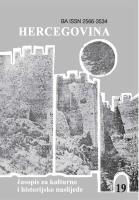Nišani na mezarju Ćejvan-ćehajine džamije u Mostaru
GRAVESTONES AT THE CEJVAN-CEHAJA'S MOSQUE MEZAR IN MOSTAR
Author(s): Saliha TanikSubject(s): Cultural history, Museology & Heritage Studies, Islam studies
Published by: Fakultet humanističkih nauka, Univerzitet »Džemal Bijedić« u Mostaru
Keywords: Mostar;Cejvan-cehaja Mosques;gravestone,
Summary/Abstract: In our study, Ottoman gravestones in the graveyard of the Kethuda Mosque in Bosnia and Herzegovina are examined and their similarities and differences with the Ottoman gravestones in Anatolia in terms of material, technique, writing, and ornamenting will be emphasized.17 gravestones were identified in the Kethuda Mosque Graveyard. 1 of the examined gravestones dates back to the 16th century while 14 of them to the 19th century. 2 of the gravestones in the graveyard were not dated as their epitaphs were destroyed.13 of the gravestones were determined as belonging to men and 4 of them to women. 16 of the graves in the graveyard were earth graves and 1 of them was a framed grave.12 of the gravestones were classified as capped square- sectioned,4 as octagonal, and 1 as triangle toppedvertical rectangle- bodied. The shape ofa quilted turban was used in 9 of the male grave caps and the shape of a fez was used in one of the male grave caps. As for the female cap types, flat tops were used as caps in two of them. Both body and cap types of all the gravestones will be provided in tables.As an epitaph, naskh was observed in 14 of the gravestones while thuluth was used in 2 and ta’liq in 1 of them. Vegetal, architectural and geometrical features were used as topics for ornamentation. 2 of the graves were indicated as belonging to a chief clerk and a mufti. The others did not indicate occupation.Ottoman gravestones in the Kethuda Mosque Graveyard in Bosnia and Herzegovina maintained the tradition of Turkish and Ottoman gravestones in neighbouring regions and Anatolia. These gravestones are not only a land certificate for the Bosnians but also a national identity.
Journal: Hercegovina
- Issue Year: 2020
- Issue No: 19
- Page Range: 83-108
- Page Count: 26
- Language: Bosnian
- Content File-PDF

